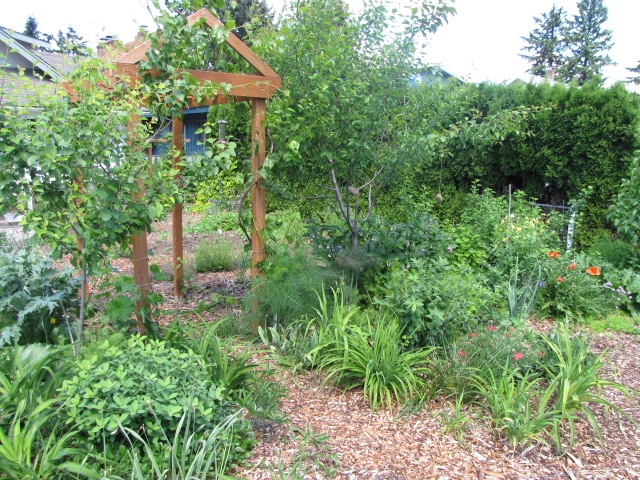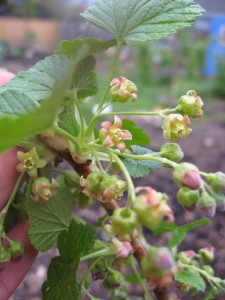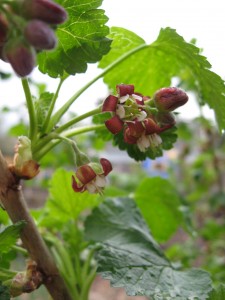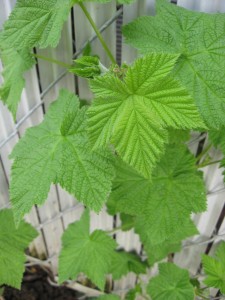Late May in the Garden Part I

It has been a long, long time since I’ve done a garden update. Â Many things have changed as a succession of new plants have been added, and ten yards of wood chips spread about. Â Nitrogen fixers and annual veggies have given way to a maturing system full of edible perennials and low-maintenance food cultivation. Â So, let’s take a quick tour of the front yard and shade gardens, shall we?
![IMG_9322[1]](https://blog.parkrosepermaculture.com/wp-content/uploads/2014/05/IMG_93221.jpg) I consider the front beds adjacent to the street to be my “good neighbor” beds. Â I try to keep them as aesthetically pleasing as possible, and let them serve as an advertisement for the beauty as well as the functionality of permaculture. Â The beds are full of spring bulbs, lilacs, and a steady succession of summer flowers such as yarrow (red, above left), salvias, columbine, and many, many others. Â The fact that these lovely plants all have medicinal or edible uses, or provide a benefit to edible plants here, is entirely on purpose.
I consider the front beds adjacent to the street to be my “good neighbor” beds. Â I try to keep them as aesthetically pleasing as possible, and let them serve as an advertisement for the beauty as well as the functionality of permaculture. Â The beds are full of spring bulbs, lilacs, and a steady succession of summer flowers such as yarrow (red, above left), salvias, columbine, and many, many others. Â The fact that these lovely plants all have medicinal or edible uses, or provide a benefit to edible plants here, is entirely on purpose.
In this bed, (clockwise from bottom left) yarrow, honeyberries, comfrey (background), love-in-a-mist, leeks, nasturtium, and a young peony all coexist quite happily, providing a mix of texture and color, and of course, food.
![IMG_9326[1]](https://blog.parkrosepermaculture.com/wp-content/uploads/2014/05/IMG_93261.jpg)
![IMG_9327[1]](https://blog.parkrosepermaculture.com/wp-content/uploads/2014/05/IMG_93271.jpg) We have five honeyberry bushes (two early and three late), all planted last year. Â This year, we will get perhaps four quarts of berries of off these edible members of the honeysuckle family. Â The early varieties are nearly ripe, and it is only May! Â Although they are a bit acidic, their flavor is similar to a blueberry mixed with a blackberry, and their extremely early ripening time, compact size and handsome shape make them a good plant for the small-scale permaculturist or home gardener.
We have five honeyberry bushes (two early and three late), all planted last year. Â This year, we will get perhaps four quarts of berries of off these edible members of the honeysuckle family. Â The early varieties are nearly ripe, and it is only May! Â Although they are a bit acidic, their flavor is similar to a blueberry mixed with a blackberry, and their extremely early ripening time, compact size and handsome shape make them a good plant for the small-scale permaculturist or home gardener.
![IMG_9330[1]](https://blog.parkrosepermaculture.com/wp-content/uploads/2014/05/IMG_93301.jpg) I love lush, closely packed groupings of plants of varying textures. Â When these plants are collected around a fruit tree, and all somehow benefit each other, we call this grouping of plants a “guild”. Â Here I have an Italian prune plum guild: Russian Bocking comfrey (dynamic accumulator and fantastic bumblebee food source), bronze fennel, which hosts beneficial insects (as do the love-in-a-mist, columbine and yarrow planted close by). Â Honeyberries, pink and white currants provide additional fruit crops at varying times. Â Rhubarb provides an early food crop, but its large leaves collect and funnel rain down to the base of the tree and its large roots help break up dense soil.
I love lush, closely packed groupings of plants of varying textures. Â When these plants are collected around a fruit tree, and all somehow benefit each other, we call this grouping of plants a “guild”. Â Here I have an Italian prune plum guild: Russian Bocking comfrey (dynamic accumulator and fantastic bumblebee food source), bronze fennel, which hosts beneficial insects (as do the love-in-a-mist, columbine and yarrow planted close by). Â Honeyberries, pink and white currants provide additional fruit crops at varying times. Â Rhubarb provides an early food crop, but its large leaves collect and funnel rain down to the base of the tree and its large roots help break up dense soil.
Perhaps you noticed the rocks hanging from the plum tree? Â What are they?
![IMG_9315[1]](https://blog.parkrosepermaculture.com/wp-content/uploads/2014/05/IMG_93151.jpg) Here is a better example on another plum tree. Â When fruit branches grow at a narrow angle (less than 45 degrees), they can easily split once loaded with fruit. Â Some varieties are more prone to narrow branching than others. Â In order to prevent damage to a tree you have spent many years caring for, it is best to help stretch young branches to a stronger angle. Â One way to do this is to tie rocks to young flexible branches until they are pulled down to a wider angle. Â By training the tree this way when it is young, it will not split under the weight of its own fruit in a few years.
Here is a better example on another plum tree. Â When fruit branches grow at a narrow angle (less than 45 degrees), they can easily split once loaded with fruit. Â Some varieties are more prone to narrow branching than others. Â In order to prevent damage to a tree you have spent many years caring for, it is best to help stretch young branches to a stronger angle. Â One way to do this is to tie rocks to young flexible branches until they are pulled down to a wider angle. Â By training the tree this way when it is young, it will not split under the weight of its own fruit in a few years.
![IMG_9338[1]](https://blog.parkrosepermaculture.com/wp-content/uploads/2014/05/IMG_93381.jpg) I am a sucker for oriental poppies. Â They have a large root and attract insects, so I think they serve a purpose in the permaculture garden. Â The way they lift the mood and make me smile means they deserve a space even if they have no other function. Â (However, the moles in the garden have taken to digging them up and killing them. Â Perhaps there are tasty grubs congregating at their roots? Â I have lost three this spring.)
I am a sucker for oriental poppies. Â They have a large root and attract insects, so I think they serve a purpose in the permaculture garden. Â The way they lift the mood and make me smile means they deserve a space even if they have no other function. Â (However, the moles in the garden have taken to digging them up and killing them. Â Perhaps there are tasty grubs congregating at their roots? Â I have lost three this spring.)
The front yard contains more beds with apples and lowbush blueberries, aronia berries, and high bush blueberries. Â It also contains lots of annual beds, which volunteers helped me plant with tomatillos, summer squash, tomatoes, kale, beets and Cape Gooseberries this week. Â But those photos are for another day, later in the summer.
On the way to the side shade garden, you must enter through a gate, over which the hops have gotten a bit rambunctious this year. Â Only May, and they are sprawling up and over everything. Â They emit a delicious herbal smell as you brush past them.
![IMG_9347[1]](https://blog.parkrosepermaculture.com/wp-content/uploads/2014/05/IMG_93471.jpg) The shade garden has a large collection of natives, including salal and evergreen huckleberry. Â It also contains non-native edibles such as goji berry, jostaberry, lingonberries, Angelica, anise hyssop, spearmint, and white currants.
The shade garden has a large collection of natives, including salal and evergreen huckleberry. Â It also contains non-native edibles such as goji berry, jostaberry, lingonberries, Angelica, anise hyssop, spearmint, and white currants.
It is suddenly getting a burst of sunshine this year since our neighbor removed a large holly tree, and I am tempted to put in a sun-loving plant right where that bolt of sunlight streams in, because the salal there is not enjoying 8 hours of bright sun.
![IMG_9361[1]](https://blog.parkrosepermaculture.com/wp-content/uploads/2014/05/IMG_93611.jpg) The thimbleberries – a thornless native raspberry relative which slowly spreads by rhizomes – are absolutely alive with the buzz of honeybees and bumblebees. Â While the fruit is not spectacular, it is a good addition to other jams and jellies, and the good it does the bees means it needs a place in every shady garden in the Northwest.
The thimbleberries – a thornless native raspberry relative which slowly spreads by rhizomes – are absolutely alive with the buzz of honeybees and bumblebees. Â While the fruit is not spectacular, it is a good addition to other jams and jellies, and the good it does the bees means it needs a place in every shady garden in the Northwest.
![IMG_9354[1]](https://blog.parkrosepermaculture.com/wp-content/uploads/2014/05/IMG_93541.jpg) We anticipate a bumper crop of elderberries in the shade garden. Â The two planted here get less than four hours of sun a day, but seem perfectly content. Â This enormous beast is a “York”, which has grown much taller than the catalog suggested it would. Â This year we will remove the oldest trunks (technically stems) which promotes the growth of new, more productive shoots from the base of the shrub.
We anticipate a bumper crop of elderberries in the shade garden. Â The two planted here get less than four hours of sun a day, but seem perfectly content. Â This enormous beast is a “York”, which has grown much taller than the catalog suggested it would. Â This year we will remove the oldest trunks (technically stems) which promotes the growth of new, more productive shoots from the base of the shrub.
![IMG_9357[1]](https://blog.parkrosepermaculture.com/wp-content/uploads/2014/05/IMG_93571.jpg) Before all the flowers are pollinated, I will harvest some this week for a batch of elderflower cordial.
Before all the flowers are pollinated, I will harvest some this week for a batch of elderflower cordial.
Hope you enjoyed the quick tour of a small part of farmette. Â Please stop back later this week with an update on the orchard, back and sideyard gardens.
Blessings on the rest of your week, and hope you have the same gorgeous spring weather we have been having here in Portland.
![IMG_9348[1]](https://blog.parkrosepermaculture.com/wp-content/uploads/2014/05/IMG_93481.jpg)



